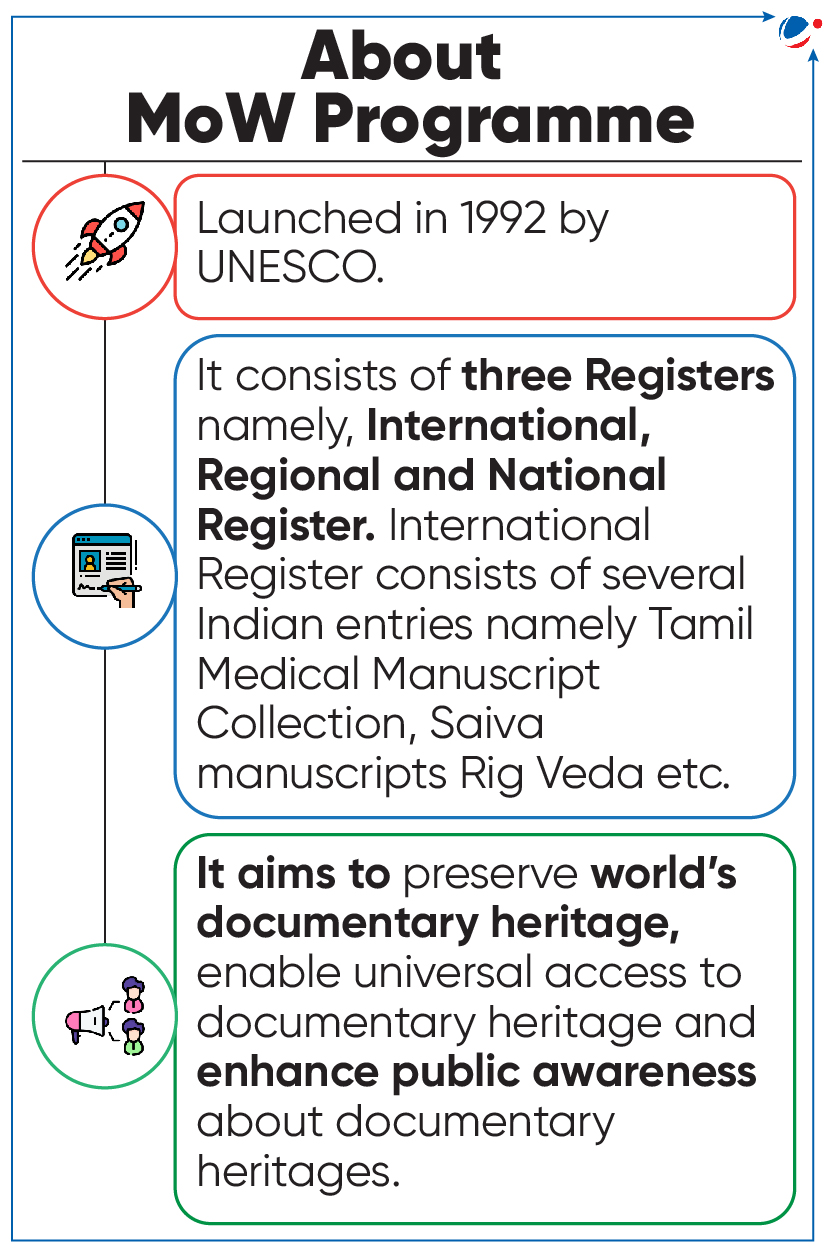UNESCO'S MOW Asia-Pacific Regional Register
UNESCO's MOW Asia-Pacific Regional Register includes Indian literary Works
- Manuscript of three Indian literary works namely Ramcharitmanas, Panchatantra and Sahṛdayāloka-Locana have been included in Memory of the World (MOW) Asia-Pacific Regional Register along with 17 other works from region.
- The decision was taken at the 10th meeting of the Memory of the World Committee for Asia and the Pacific (MOWCAP), held at Ulaanbaatar, Mongolia.
About Literary Works
Ramcharitmanas
- Written in the 16th Century by Goswami Tulsidas.
- An epic poem written in Awadhi language and consists of Seven Kāndas.
- Poetic retelling of the events of Ramayana.
Panchatantra
- Written by Pt. Vishnu Sharma in Sanskrit.
- One of the oldest collection of surviving Indian Fables
- Consists of five parts and its most distinguishing feature is the 'Story within story' structure.
Sahṛdayāloka-Locana
- Written by Acharya Anandvardhan in Sanskrit and is a text of Indian Poetics.
- Philosopher Abinava Gupta has written a commentary on it.

- Tags :
- UNESCO
- Memory of the World
- Ramcharitmanas
Sahitya Akademi
Ruskin Bond was awarded the Sahitya Akademi Fellowship.
- Fellowship is the highest honour conferred by Akademi on a writer.
- It is reserved for 'the immortals of literature'.
- Major literary of Ruskin Bond: Vagrants in the Valley, Once Upon a Monsoon Time, Angry River, Strangers in the Night, All Roads Lead to Ganga, etc.

- Tags :
- Sahitya Akademi
- Ruskin Bond
Deda Method
Muria tribes practice the deda, traditional method of preserving seeds.
About Deda Method
- Seeds are wrapped in leaves, packed tightly to look like boulders, and woven with Siali leaves.
- Benefits: Protection of seed from pests and worms, which can be stored and used upto 5 years.
About Murias
- Sub-group of Gond tribe, belonging to Chhattisgarh.
- Associated with Muria Rebellion of Bastar (1876) against Gopinath Kapardas, diwan of Bastar.
- Customs: Dead pillars (Gudi), where dead are buried with a stone placed 6 to 7 feet high and Ghotul where young boys and girls chose their own life partner.
- Tags :
- Deda Method
- Murias
Lushai Tribe
A rare hemi-parasitic terrestrial plant (Phtheirospermum lushaiorum) has been found in Phawngpui National Park of Mizoram.
- Lushaiorum is named after “Lushai” tribe of Mizoram.
About Lushai tribe
- Tribe under Kuki-Chin group of tribes.
- Commonly known as Mizos and racially they are known to be under Mongoloid origin.
- Main occupations are Jhum and orange Cultivation.
- Lusai are known as Head Hunter community.
- Popular Dance is Bamboo Dance (Cheraw-dance).
- Basic unit of Lushai (Mizo) society is a patrilocal joint family with patrilineal descent and inheritance rules.
- Lushai (Mizo) society is patrilocal joint family with patrilineal descent and inheritance rules.
- Tags :
- Bamboo Dance
- Lushai Tribe
- Mizoram
Avars
DNA analysis of ancient graves has revealed insights on the social life of Avars
About Avars
- They are nomadic people who survived in eastern central Asia between 6th-9th century.
- Considered as successors of the Huns by their way of life and warfare.
- They followed strict patrilineal descent (father's line)
- They were hired by the Byzantine Empire to subdue other tribes
- They avoided inbreeding and practised limited intermarriage with non-Avar neighbours.
- They are renowned among archaeologists for their distinctive belt garnitures.
- Tags :
- Avars
- Huns
- Byzantine Empire



